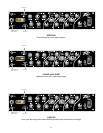
6
14–22 3-band parametric EQ
Each band of the parametric EQ section has a control for: cut/boost; bandwidth (Q) and frequency. This is a full
parametric EQ! All three bands of parametric EQ overlap‚ giving you control over the entire tonal spectrum.
14‚ 17‚ 20 cut/boost
This control behaves like any other active EQ control where CW (clockwise) rotation provides boost‚ CCW
(counterclockwise) rotation provides cut and the 12 o’clock position (detent) provides no action at all (no cut or
boost).
15‚ 18‚ 21 bandwidth (Q)
The bandwidth controls determine how wide or narrow a range of tones will be affected by the cut/boost control.
For instance‚ when the bandwidth control is fully CCW‚ the cut/boost control will affect a wide range of
frequencies (wide bandwidth = low Q). When the bandwidth is fully CW‚ the cut/boost will affect a very narrow
range of tones (narrow bandwidth = high Q). If the bandwidth control is somewhere between the two extremes‚
the bandwidth will likewise be somewhere between wide and narrow. As the control is rotated CW‚ the bandwidth
gets narrow. As the control is rotated CCW‚ the bandwidth gets wide. A good place to start is with the bandwidth
set to the 3 o’clock position. This is roughly where many “semi-parametric” EQs are set.
16‚ 19‚ 22 frequency
The frequency controls determine the center point at which the cut/boost will take action. Think of the bandwidth
control affecting the range of tones being acted upon and the frequency control determining the center point of
those tones.
Note about frequencies:
The electric bass generates notes with frequencies ranging from about 30.9 Hz (low B-string on a five-string bass)
to about 523.3 Hz (high C-string on a six-string bass). It may help you to think of frequencies as notes on your
instrument or notes that you sing. By doing this‚ the concept of bandwidth and frequency becomes easier to
understand. The bandwidth control determines the number of notes being affected and the frequency control
determines the center of that range of notes.
Below are a few more pitches with their corresponding frequencies:
Four-string bass:
E string = 41.2 Hz
A string = 55.0 Hz
D string = 73.4 Hz
G string = 98.0 Hz
23 master volume
This knob controls the overall volume level of the system.
24 DDT
™
enable/disable switch
DDT speaker protection is disabled when the button is depressed or in the “in” position. DDT should be enabled at all
times to protect your speakers.
25 power LED/DDT indicator
The LED is green when the power switch is in the “on” position. During normal operation‚ this LED also acts as a DDT/clip
indicator. The LED illuminates red when DDT speaker protection is taking place or when the power amp is clipping (if DDT
is disabled).
26 power switch
Used to turn AC mains power on or off.


















